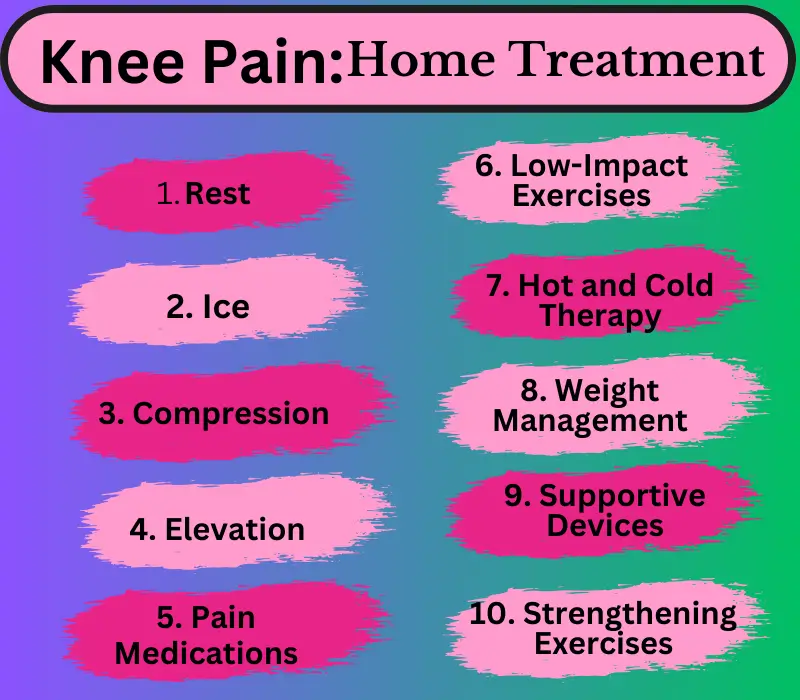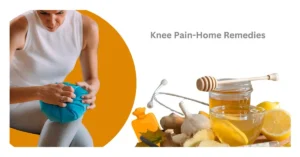Learn effective home remedies for knee pain relief. Learn about natural treatments, exercises, and dietary tips to alleviate knee pain and improve joint health.
Thank you for reading this post, don't forget to subscribe!Understanding Knee Pain: Causes and Symptoms
Knee pain is a common affliction that affects people of all ages. It can result from an injury, such as a ruptured ligament or torn cartilage, and medical conditions, including arthritis, gout, and infections. Recognizing knee pain’s underlying causes and symptoms is crucial for effective treatment.
Common Causes of Knee Pain
- Injuries: Sprains, strains, and fractures.
- Arthritis: Osteoarthritis, rheumatoid arthritis, and gout.
- Overuse: Repetitive motions leading to conditions like tendinitis.
- Bursitis: Inflammation of the bursae, the tiny sacs of fluid that cushion the outside of your knee joint.
Symptoms to Watch For
- Swelling and stiffness
- Redness and warmth to the touch
- Weakness or instability
- Popping or crunching noises
- Inability to fully straighten the knee
Home Remedies for Knee Pain Relief
1. Rest and Activity Modification
Knee discomfort, typically from overuse or injury, responds well to rest. Avoid activities that exacerbate the pain and allow the knee to heal. Engaging in high-impact exercises like running or jumping can worsen the condition. Instead, incorporate low-impact exercises such as swimming or cycling to maintain fitness without straining the knee. These activities help keep the muscles around the knee strong and flexible, promoting better joint support and overall knee health.
2. Ice and Heat Therapy
Applying ice packs to the knee can significantly reduce inflammation and numb the area, relieving acute pain. Use ice packs for 15-20 minutes every few hours during the first 48 hours after the onset of pain. This initial period is crucial for minimizing swelling and controlling pain. After this period, heat therapy becomes beneficial. Applying a warm compress or heating pad to the knee helps relax and loosen tissues and stimulates blood flow to the area, aiding the healing process and reducing stiffness.
3. Compression and Elevation
Using a compression bandage helps reduce swelling and supports the knee, which can be especially beneficial during activities that might strain the knee. Ensure the bandage is snug but not so tight that it impedes circulation. Elevating the knee above heart level also reduces swelling by allowing fluids to drain away from the area. Lying down and raising your leg on cushions is an easy way to accomplish this.
4. Over-the-Counter Medications
Nonsteroidal anti-inflammatory drugs (NSAIDs) like ibuprofen and naproxen can effectively reduce pain and inflammation. These medications work by blocking substances in the body that cause inflammation. Always follow the recommended dosage instructions and consult a healthcare provider if you have concerns or are taking other medications to avoid potential interactions.
5. Massage with Oil for Knee Pain Relief
Massaging the knee with oil can provide several benefits for knee pain relief. Oils like olive and coconut, and essential oils like eucalyptus or peppermint have anti-inflammatory and analgesic properties that can help reduce pain and inflammation.
Benefits of Oil Massage:
- Improved Blood Circulation: Massaging with oil stimulates blood flow to the affected area, speeding up the healing process.
- Reduced Muscle Tension: Regular massage helps to relax tense muscles around the knee, reducing pain and improving flexibility.
- Increased Joint Lubrication: Oils can help lubricate the knee joint, reducing stiffness and enhancing mobility.
How to Perform Oil Massage:
- Warm the Oil: Slightly warm the oil you choose to enhance its soothing effects.
- Apply Gently: Rub the warm oil onto the knee area gently in, circular motion.
- Massage Duration: Continue massaging for 10–15 minutes, allowing the oil to penetrate the skin.
- Repeat Regularly: For best results, perform this massage 1-2 times daily.
Precautions:
- Skin Sensitivity: Ensure you are not allergic to the oil by doing a patch test before regular use.
- Proper Technique: Avoid applying too much pressure, which could aggravate the pain.
Incorporating oil massage into your knee pain management routine can complement treatments like rest, ice, and compression, providing holistic relief and promoting overall joint health.
In a nutshell, you can easily understand all the above by the following diagram:
Physical Therapy and Exercises for Knee Pain Relief
Strengthening Exercises
Strengthening the muscles around the knee, particularly the quadriceps, hamstrings, and calves, can provide better support to the knee joint.
Quadriceps Strengthening:
- Straight Leg Raises: Lie on your back with one leg bent and the other straight. Slowly lift the straight leg to about the height of the bent knee. Hold for a few seconds, then lower it back down. Repeat 10-15 times.
Hamstring Strengthening:
- Hamstring Curls: Stand behind a chair and hold onto it for support. Slowly bend one knee, bringing your heel toward your buttocks. Hold for a few seconds, then lower it back down. Repeat 10–15 times on each leg.
Flexibility and Stretching
Keeping the knee flexible can prevent stiffness and improve the range of motion. Gentle stretching exercises should be part of your daily routine.
Calf Stretch:
- Stand facing a wall with your hands on the wall at eye level. Step one leg back, keep it straight, and bend the front knee. Press the back heel into the floor and hold for 20–30 seconds. Switch legs and repeat.
Alternative Treatments
Acupuncture
Acupuncture involves inserting thin needles into specific points on the body to relieve pain. Some studies suggest that acupuncture can help reduce knee pain and improve function, particularly in individuals with osteoarthritis.
Herbal Remedies for Knee Pain Relief
Certain herbs have anti-inflammatory properties that can help alleviate knee pain.
Turmeric:
- Turmeric Tea: Boil a cup of water with a teaspoon of turmeric powder. Add honey and lemon for taste. Drink this twice daily for its anti-inflammatory benefits.
Ginger:
- Ginger Compress: Grate fresh ginger and apply it to the affected area for 20-30 minutes. Ginger can also be consumed in tea or as a supplement.
When to See a Doctor
While home remedies can be effective, it is essential to seek medical attention if you experience severe pain, significant swelling, or an inability to bear weight on your knee. Persistent symptoms may indicate a more severe condition that requires professional treatment.
FAQs on Knee Pain Relief
Q. What is the fastest way to relieve knee pain?
The quickest way to alleviate knee pain is through the R.I.C.E. method, an easy-to-remember acronym for Rest, Ice, Compression, and Elevation. Begin by giving your knee a well-deserved break; find a comfortable spot and let it rest to prevent any further strain. Next, pamper your knee with a soothing ice pack, wrapping it gently around the affected area for 15 to 20 minutes.
This icy embrace will help calm the throbbing pain and reduce inflammation. Afterward, snugly apply a compression bandage, wrapping it around your knee to provide supportive pressure that helps to limit swelling. Finally, elevate your knee—prop it up on pillows or cushions so it sits above heart level. This simple act encourages excess fluid to drain away, further diminishing swelling and promoting healing.
Q. How can I control my knee pain naturally?
You can control knee pain naturally by:
- Maintaining a healthy weight reduces pressure on your knees.
- Engaging in low-impact exercises such as swimming or cycling.
- Strengthening muscles around the knee with exercises like leg raises and hamstring curls.
- Using herbal remedies such as turmeric and ginger for their anti-inflammatory properties.
- Applying ice packs to reduce inflammation and heat therapy to relax muscles.
- Practicing yoga or stretching to improve flexibility and reduce stiffness.
Q. What can I drink to stop knee pain?
To help alleviate knee pain, you can drink:
- Turmeric tea: It is known for its anti-inflammatory properties.
- Ginger tea: It helps reduce inflammation and pain.
- Green tea: It contains antioxidants that can help reduce inflammation.
- Cherry juice is rich in antioxidants and can help reduce pain and inflammation.
Q. How can I lubricate my knees naturally?
To naturally lubricate your knees, consider:
- Staying hydrated: Drink plenty of water to maintain the fluid balance in your joints.
- Consuming omega-3 fatty acids found in fish oil, flaxseeds, and chia seeds can help reduce inflammation and improve joint lubrication.
- Eating foods rich in hyaluronic acid, such as bone broth, soy-based foods, and citrus fruits, helps maintain joint fluid.
Q. Which fruit is best for knee pain?
Cherries are a vibrant and delicious ally in the battle against knee pain. Bursting with deep red color, these succulent fruits are packed with powerful antioxidants, especially anthocyanins, which work wonders in reducing inflammation and soothing discomfort. But cherries are not alone in this fight; other fruits, like sweet, juicy berries, zesty oranges, and tropical pineapples, also brim with antioxidants that can help alleviate knee pain. Incorporating these colorful and nutritious options into your diet can provide relief and enhance your overall well-being.
Q. Is milk good for knee pain?
Milk can be good for knee pain as it is a rich source of calcium and vitamin D, both essential for bone health. Adequate intake of these nutrients can help maintain strong bones and reduce the risk of osteoporosis, which can contribute to knee pain. However, those with lactose intolerance or milk allergies should seek alternative calcium-rich foods.
Conclusion
Effectively managing knee pain involves a delicate blend of rest, targeted physical therapy, natural home remedies, and, when the situation calls for it, professional medical intervention. By embracing a holistic approach, individuals can embark on a journey of healing that includes thoughtful lifestyle adjustments. This comprehensive strategy not only alleviates knee pain but also enriches overall well-being, allowing individuals to reclaim the joys of movement and improve their quality of life.
Read more articles on Health and Wellness Tips.
You might like to read:




